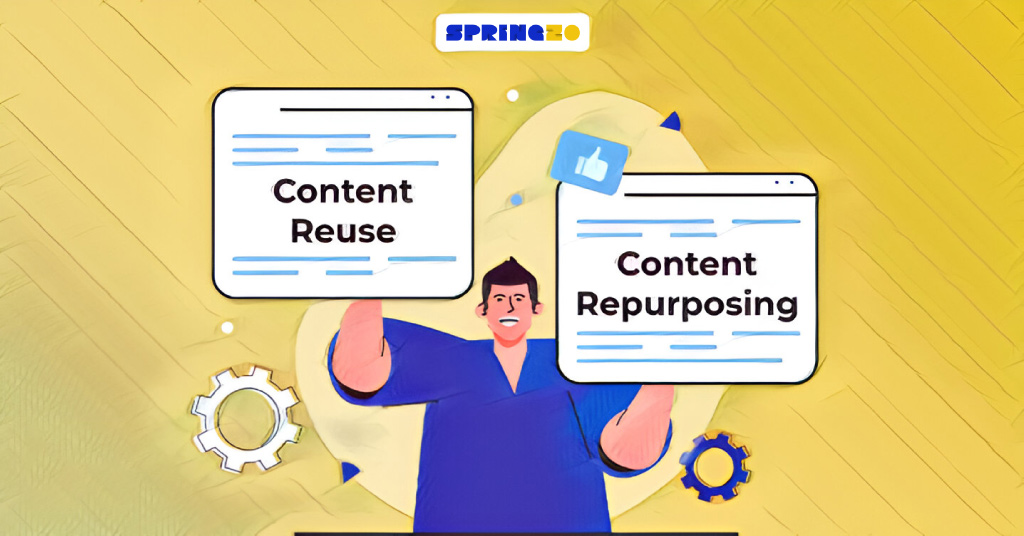In the world of digital marketing, content still remains the king. Whether you’re a startup seeking to make its mark or an established enterprise looking to maintain its competitive edge, the role of content in your strategy cannot be overemphasized.
That said, not all content strategies need to be developed from scratch. Sometimes, the most effective approach involves adding more value to what you’ve already created. This brings us to a commonly misunderstood aspect of content strategy: the difference between reuse and repurpose. Understanding this distinction is essential for any business aiming to maximize its content efforts.
What is Content Reuse?
Content reuse is the practice of taking existing content and using it in multiple contexts or platforms without significantly altering its core message or format.
This could range from sharing the same blog post on different social media channels to using key statistics from a research report in various presentations. The idea is to extend the reach and lifespan of your existing content.
Benefits of Content Reuse
Time-Saving: One of the biggest advantages of content reuse is the time you save. You don’t need to reinvent the wheel each time you need to disseminate information.
Consistency: When you reuse content, you maintain a consistent message across various platforms, which can reinforce your brand image.
What is Content Repurposing?
Content repurposing, on the other hand, involves taking existing content and adapting it for a different medium or target audience. For instance, you could transform a blog post into a YouTube video or distill the main points of a podcast into an infographic.
However, this involves more than a simple copy-paste; you might need to reformat, edit, or even expand upon the original material.
Benefits of Content Repurposing
Reaching New Audiences: Different types of content appeal to different types of audiences. Repurposing allows you to broaden your reach.
Increased ROI: If a particular piece of content performs exceptionally well, repurposing it can amplify its impact, maximizing your return on investment.
Knowing the difference between reuse and repurpose is more than a matter of semantics; it’s a strategic decision that can affect your content’s reach, longevity, and overall effectiveness. Make this distinction a cornerstone of your content strategy, and you’re on your way to maximizing your content’s potential.
4 Key Differences Between Content Reuse and Repurpose
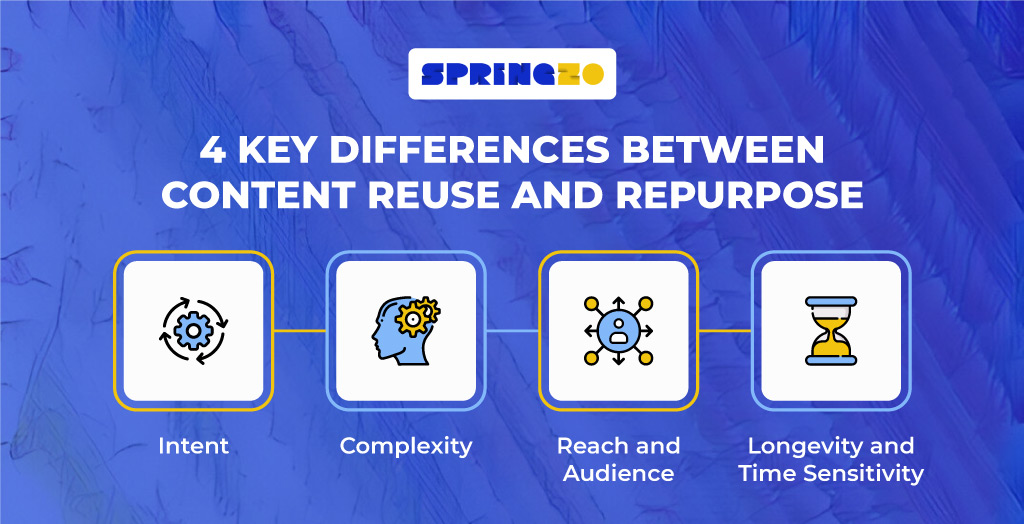
Understanding the nuances between these content strategies can be the tipping point for a successful digital marketing campaign. In particular, grasping the difference between reuse and repurpose can allow you to unlock the full potential of your existing content.
Here, we delve deeper into four critical areas that distinguish these two approaches.
1. Intent
The first and perhaps most fundamental difference between reuse and repurpose is the intent behind each strategy. Content reuse focuses on leveraging existing material ‘as is’ to maximize its reach across different platforms or contexts.
On the other hand, the intent behind content repurposing is to adapt the material for a different medium, format, or audience. This is why content reuse often requires minimal and cosmetic changes to the original content, while repurposing may involve a comprehensive transformation.
2. Complexity
Complexity is another area where the difference between reuse and repurpose becomes apparent. Content reuse is typically less complex, as it involves little to no modification of the original content. This strategy is often as straightforward as reposting a blog article on various social media platforms or sharing a video clip in multiple online communities.
Content repurposing, by contrast, usually involves a higher level of complexity. This could mean adapting an informative blog post into an interactive webinar, transforming a detailed report into a series of snackable social media posts, or converting a podcast episode into an engaging short-form video.
These transformations require specialized skills, such as graphic design, video editing, or scriptwriting.
3. Reach and Audience
When discussing reach and audience, the difference between reuse and repurpose comes into sharp focus. Reusing content typically aims at reaching the same or similar audience segments but across various channels.
Repurposing, on the other hand, can significantly broaden the audience and capture more leads by adapting the content to different formats or platforms that attract unique demographics.
4. Longevity and Time Sensitivity
The final point of divergence, or difference between reuse and repurpose, pertains to the lifespan and time sensitivity of the content. Content that is merely reused can risk becoming stale or redundant if overutilized.
Repurposing content, however, can extend its shelf-life. By transforming the content to suit different platforms or audience needs, you can continue to breathe new life into what might otherwise become outdated material.
To sum it up, the difference between reuse and repurpose lies in the underlying intent, the complexity of execution, the reach and audience targeted, and the longevity and time sensitivity of the content. This knowledge entitles you to maximize your content’s reach, resonance, and ROI.
When to Use Content Reuse vs. Content Repurposing
Optimizing a content strategy requires making specific choices, often under constraints of time, resources, and business goals. It is, therefore, crucial to know when to apply which strategy, whether that’s content reuse or content repurposing. By understanding the difference between reuse and repurpose, you can align your content initiatives more closely with your objectives.
In this section, we will explore various scenarios where each strategy may be most beneficial.
Scenarios for Content Reuse
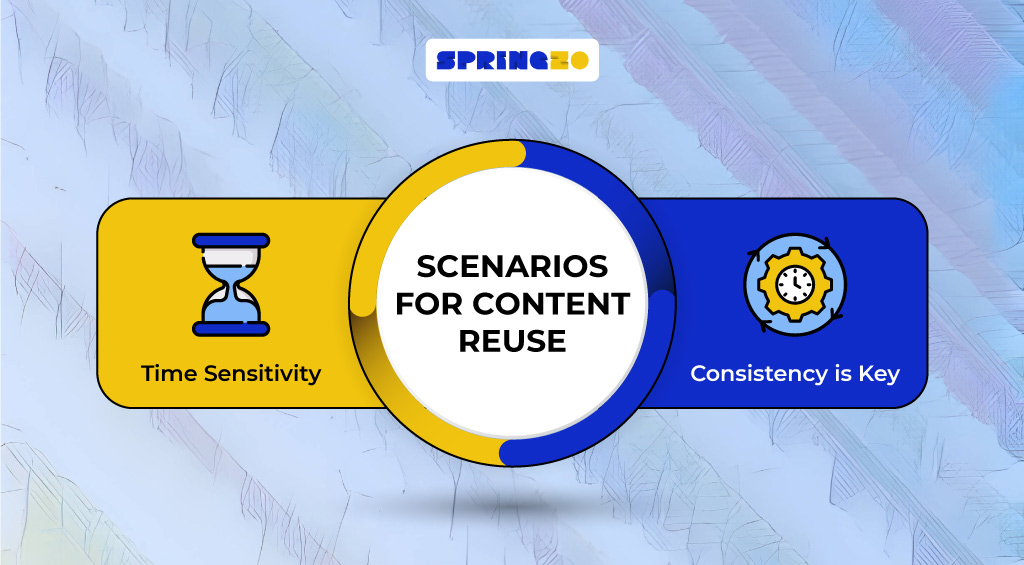
Content reuse can be highly efficient in certain situations. Recognizing where to apply this strategy can make a tangible difference in your content operations. Here are some scenarios where understanding the difference between reuse and repurpose can guide you toward reusing content:
1. Time Sensitivity
Content reuse may be the most practical approach if you’re working under a tight deadline and need to get information out quickly. Since this strategy requires little modification, it allows for rapid dissemination.
2. Consistency is Key
When the primary objective is to send a unified message across multiple channels, reusing content ensures consistency.
This is particularly important for announcements, product launches, and campaigns that hinge on a singular message.
Scenarios for Content Repurposing
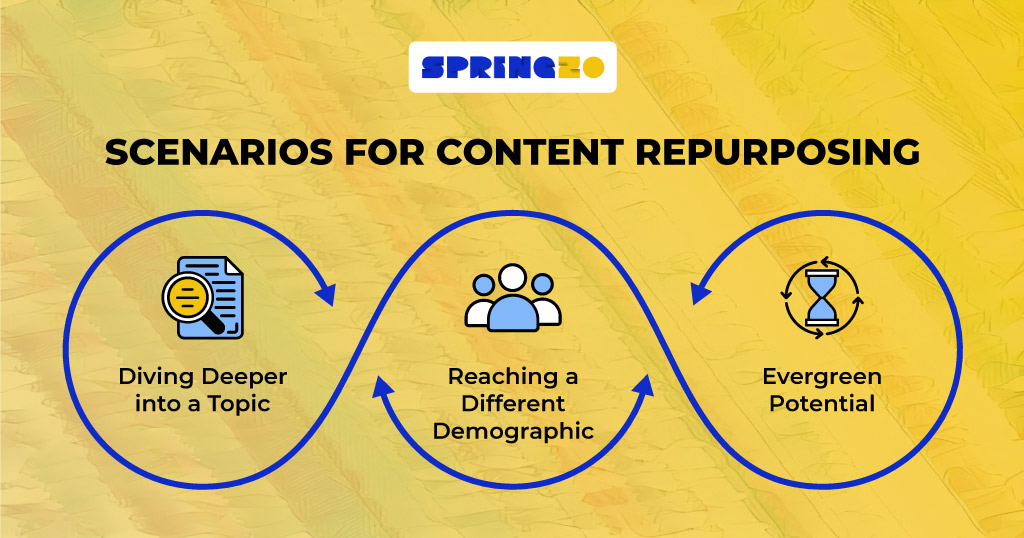
On the other side of the spectrum, there are situations where repurposing is more appropriate. The difference between reuse and repurpose is crucial here, as these situations often call for more extensive modifications:
1. Diving Deeper into a Topic
Repurposing is your go-to strategy if you wish to delve deeper into a specific topic or a subject. For example, you could transform a brief blog post into a comprehensive whitepaper or an engaging webinar.
2. Reaching a Different Demographic or Platform
Understanding the difference between reuse and repurpose becomes vital when you aim to capture a new audience segment. By repurposing content, you can adapt it to suit the diverse consumption habits and preferences of a different demographic or user base.
3. Evergreen Potential
When you have content that’s timeless, you can continuously repurpose it to keep it fresh and relevant. This contrasts with reusing content, which may become stale if not updated or adapted.
Best Practices for Both Content Strategies
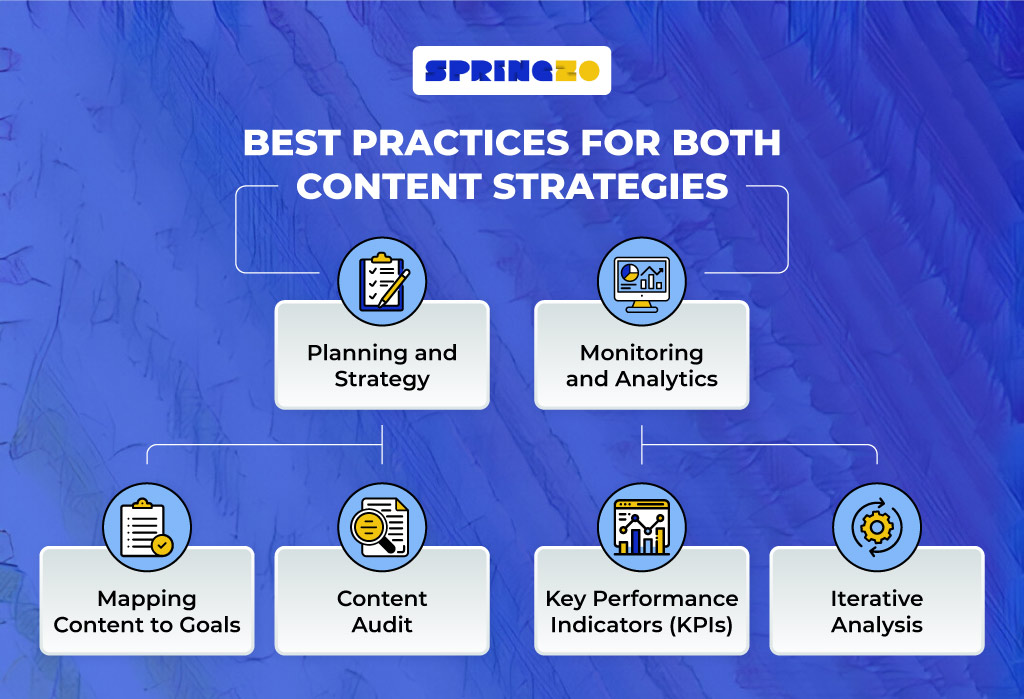
Once you’ve understood the difference between reuse and repurpose, the next step is to implement these strategies effectively. Both approaches have their merits but require thoughtful planning and execution to realize their full potential.
In this section, we’ll explore the best practices that apply to both content reuse and content repurposing, further emphasizing how understanding the difference between reuse and repurpose can enhance your content strategy.
Planning and Strategy
Planning is a universal best practice, regardless of whether you’re reusing or repurposing content. Before taking either route, you need to identify your goals, target audience, and key performance indicators (KPIs). Only by doing so can you make an informed decision that takes into account the difference between reuse and repurpose.
1. Mapping Content to Goals
Ensure that your content aligns with your overall business objectives. For instance, content reuse might be more appropriate if your goal is quick dissemination. However, content repurposing should be your strategy of choice if you’re looking to penetrate new markets or demographics.
2. Content Audit
Before reusing or repurposing, perform a content audit to identify what you already have. An audit not only tells you what’s available but also what’s performed well in the past, making it easier to decide between reuse and repurposing.
Monitoring and Analytics
Both content reuse and repurposing benefit from a strong monitoring and analytics strategy. Understanding the difference between reuse and repurpose here is key: reused content may have metrics focused on reach and engagement within existing audience segments, while repurposed content might require tracking new audience behaviors and engagement levels.
1. Key Performance Indicators (KPIs)
Identify KPIs specific to your goals. For reused content, metrics like reach, clicks, and engagement rates are critical.
For repurposed content, you may need to look at
- Conversion rates
- Customer acquisition costs
- Customer lifetime value, especially if you’re targeting new audience segments.
2. Iterative Analysis
The beauty of digital content is its flexibility. You can make adjustments if you don’t get the desired results the first time. The difference between reuse and repurpose should inform how you adjust: tweaking the messaging or delivery channels might suffice with reused content, while repurposed content might require more substantial revisions.
List of Tools for Content Repurposing and Reuse
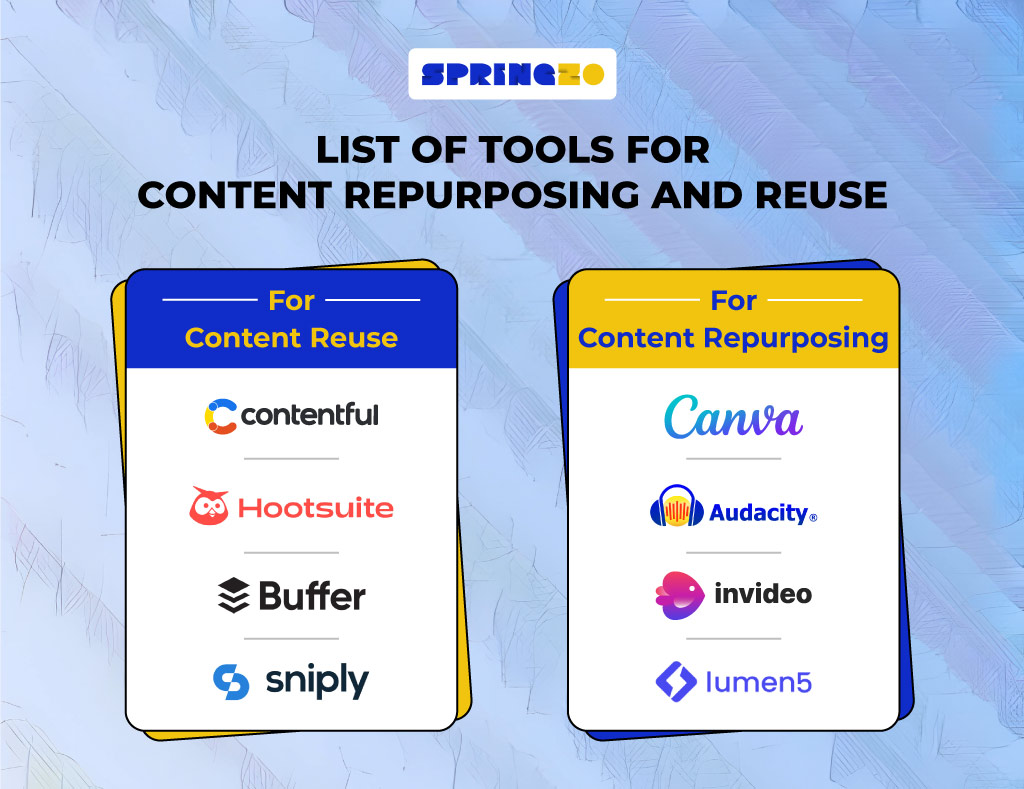
Here are some tools that can help:
For Content Reuse
Contentful: A headless CMS that allows you to manage and distribute content across multiple platforms easily.
Hootsuite: A social media management tool ideal for reusing content across various social networks.
Buffer: Similar to Hootsuite, Buffer allows for the easy scheduling and reposting of content.
Sniply: Attach a call-to-action to every link you share, useful for reusing content and driving conversions simultaneously.
For Content Repurposing
Canva: Great for converting written content into visually appealing infographics, slides, or social media posts.
Audacity: An audio editing software ideal for transforming video content into podcasts or vice versa.
InVideo: Convert your articles or blog posts into engaging videos.
Lumen5: AI-driven tool that transforms blog posts into social videos, making the repurposing process more efficient.
Unleashing the Power of Your Content
If you’re ready to take your content strategy to the next level, it’s time to assess your existing content. Consider how you can implement content reuse for time-sensitive or consistency-driven campaigns and how content repurposing could unlock new audience segments and offer deeper engagement.
But if you’re looking for a comprehensive solution that allows you to focus on your core business activities while experts manage the complexities of content transformation, Springzo should be your partner of choice.
Springzo embodies the philosophy that to repurpose is not just to recycle but to reimagine, redefine and re-innovate. We believe in turning your existing content into versatile, dynamic assets that resonate with a variety of audiences. From morphing long-form articles into digestible social media posts to designing compelling infographics, Springzo offers a range of services fine-tuned to meet your specific content needs.
When you combine a thoughtful approach to distinguishing the difference between reuse and repurpose with a committed partner like Springzo, you transform your existing content into one of your most adaptable and influential assets.
Ready to revamp your content strategy? Reach out to us today and turn your content into a powerhouse of possibilities!
Frequently Asked Questions (FAQs)
1. How does SEO factor into the decision to reuse or repurpose content?
SEO considerations are critical but generally differ between reusing and repurposing content. When you reuse content, you’re likely aiming at improving topical authority, but you must be cautious about duplicate content issues that could impact SEO negatively. On the other hand, repurposing can broaden your keyword portfolio by allowing you to target different keywords relevant to the new format or audience.
2. Can I both reuse and repurpose the same piece of content?
Absolutely, a single piece of content can be both reused and repurposed, though usually not simultaneously.
For example, you might first reuse a blog post by sharing it across multiple social media channels. Later on, you could repurpose it into a webinar or an infographic. Each strategy targets different objectives and can be part of a well-rounded content lifecycle.
3. What are some common pitfalls to avoid when reusing or repurposing content?
When reusing content, one common mistake is over-saturation; using the same content too often can lead to audience fatigue. Another issue is failing to update time-sensitive information, making the content outdated or irrelevant.
For repurposing, a common pitfall is not sufficiently adapting the content for the new format or audience, which could result in a mismatch between the content and the platform or audience expectations. Another mistake is repurposing without a clear objective, leading to diluted impact.
4. Are there any legal considerations when reusing or repurposing content?
Legal considerations can come into play, particularly if you’re considering reusing or repurposing content that involves third-party materials, like quotes, images, or data. Always ensure you have the appropriate permissions or licenses, and provide proper attribution where required to avoid copyright infringement issues.
